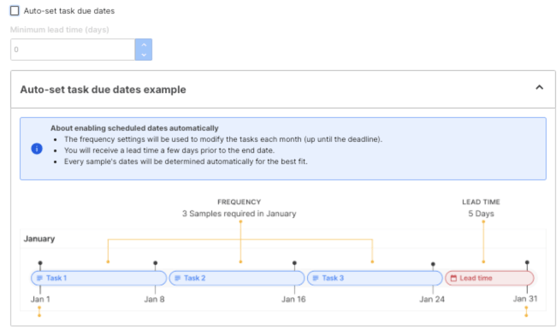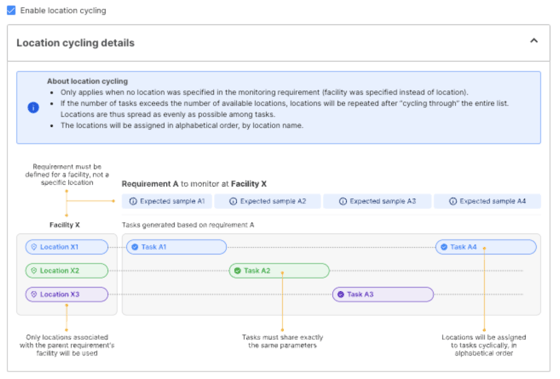Generate Sampling Tasks and Organize Tasks page Tabs
The Klir system offers robust capabilities in generating tasks for monitoring plans, significantly streamlining your workload.
By automating task generation, Klir not only saves you valuable time but also enhances organizational efficiency.
You have the flexibility to specify task details such as dates, locations, and even integrate work order IDs as necessary, ensuring comprehensive management and traceability of tasks throughout their lifecycle.
This integrated approach empowers users to focus more on strategic activities while Klir efficiently handles the operational aspects of task management.
After Clicking on the Generate Tasks button:
You will be directed to the Organize Tasks page:
Improved Task Auto Generation Modal
The new "Date scheduled" tab in the task auto generation modal gives you more control over scheduling expected samples. This makes it easy to change sample dates, improving flexibility and efficiency.
Auto set task due dates:
Generate tasks based on the frequency and the number of samples required.
For instance, if you require two samples every month for copper and the due date is set for the 30th of September, tasks will be generated for the first sample on the 15th and the second sample on the 30th of September.
Specifying a lead time:
With the "Auto set task due dates" feature, you can now set a lead time to specify how many days before the frequency end date samples should be collected. This ensures samples are evenly distributed. For example, a two-day lead time will schedule the first copper sample for September 14th and the second for September 28th.
 |
The introduction of the “Location” tab when using task auto generation enhances the distribution of sampling locations for requirements associated with facilities. When generating tasks for a facility-linked requirement, you can enable “location cycling,” a feature that assigns different locations to each task from the set associated with the facility. This distribution follows an alphabetical order, ensuring an even spread of tasks across locations. Once all locations have been assigned a task, the process repeats for the remaining tasks until all are accounted for within the facility. This feature streamlines the task assignment process, ensuring a systematic and efficient distribution of tasks across various locations.
 |